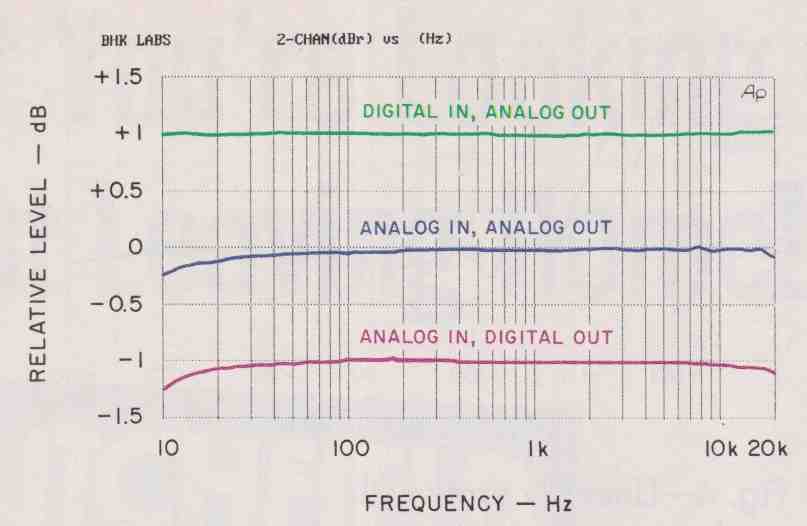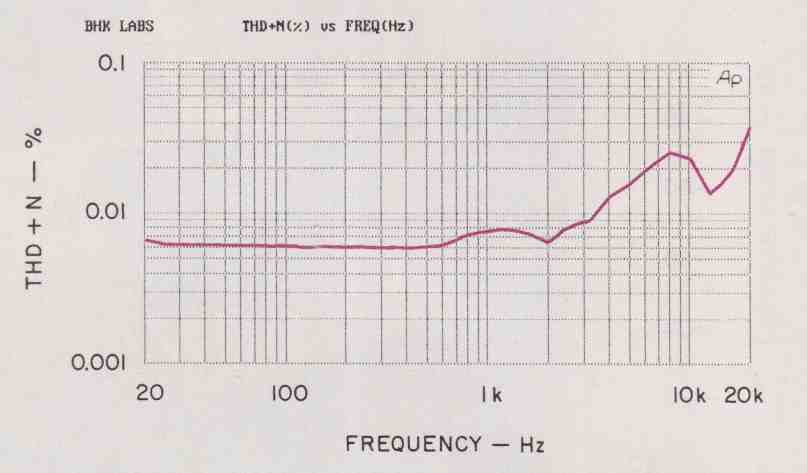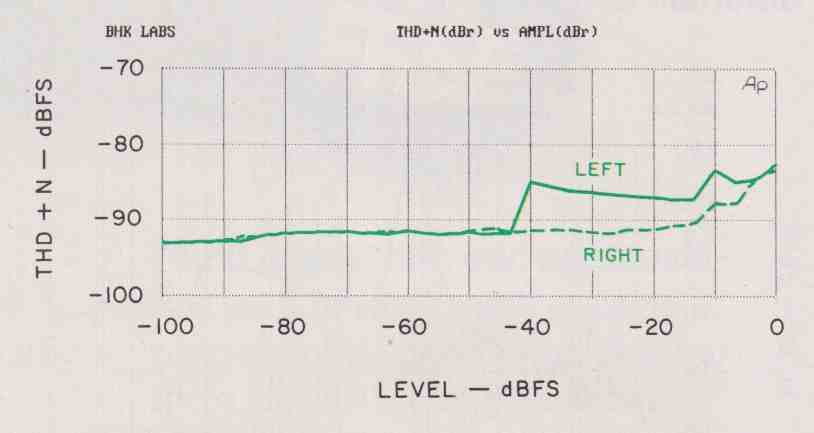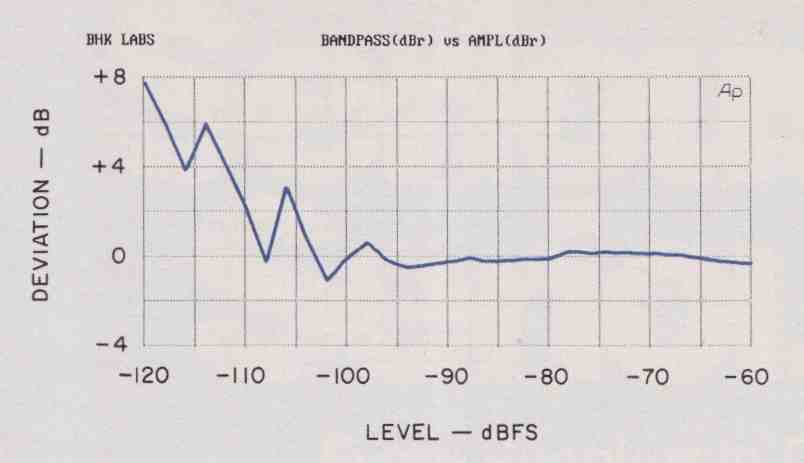
Fig. 5—Multitone noise and distortion test; see text.
| Home | Audio mag. | Stereo Review mag. | High Fidelity mag. | AE/AA mag. |
Dimensions: 17 in. W x 5¼ in. H x 13 in. D (43.4 cm x 13.4 cm x 34 cm).
Weight: 14.1 lbs. (6.4 kg). Price: $599.
Company Address: 222 New Rd., Parsippany, N.J. 07054; 973/575-7810; www.del.denon.com.
Despite MiniDisc’s admirable and sophisticated technology, it has not yet taken the consumer market by storm, at least in this country. The format is, however, getting extensive professional use in broadcast studios, for presentations, and in other areas where its fast random track access, easy and versatile editing, long-term storage integrity, and high-quality sound are appreciated.


In the few years since MiniDisc (MD) was introduced, its ATRAC data-reduction system has been improved significantly, and its sound quality is now quite good—so good, some say, that MD copies of CDs are almost indistinguishable from the originals. And MD’s editing flexibility is far greater than recordable CD or even DAT can offer. MD recorders can divide, re-sequence, and recombine recorded tracks. Even track deletion works differently from tape, as MD automatically skips erased tracks in playback and can make long recordings on space freed up by erasing short tracks that were not originally adjacent to each other. Disc and track titles can be encoded on the discs, to be read on any MD player’s display. Recording time per disc is normally 74 minutes, same as on CD—but you can double that time by recording each track separately, in mono.
Unlike companies whose MD products consist only of portables or tabletop stereos, Denon offers serious MiniDisc equipment, including professional units and the full-featured DMD-1000 under review. Like most MD recorders, it has a built-in sampling-rate converter that enables direct digital recording from sources with sampling rates of 32 or 48 kHz as well as the 44.1-kHz sampling rate of MiniDisc and CD.
Five pushbuttons near the upper right corner of the DMD-1000’s front panel control the main transport functions (eject, play, stop, pause, and record), much like a tape deck’s controls. Just below these but tons are four more that, like most of the controls at this end of the panel, are for editing. These four buttons handle manual fast forward and reverse shuttling and two editing functions, “Edit” and “Enter.” Farther down the panel are two knobs and four small pushbuttons. One knob adjusts analog input level; the other is a jog dial for finding track beginnings and selecting characters for titles. To enter the character you’ve selected, you push one of the but tons (“Character”). The other buttons are “Recovery” (which recovers disc space by gathering together pieces of recording space lost in prior editing), “Clear” (for programmed tracks or for titles), and a monitor switch that enables you to hear the input signal without pressing the 1000’s record button.
The Denon’s disc drawer is at the top center of the front panel. Beneath it is a fluorescent display, which incorporates level meters. At the top left of the panel are slide switches for timer start and selecting mono or stereo recording mode. The power switch is at the lower left of the panel. To its right is a headphone jack and two rotary controls, one for headphone volume and the other for input selection. Although the DMD-1000 has four inputs (two Toslink optical, one coaxial digital, and one stereo pair of analog jacks), the selector has five positions. That’s because it has two settings for analog input, one for use with Analog Track Marking (A.T.M.) and one for use without. This feature automatically adds track numbers whenever the signal you’re recording goes silent for 1½ seconds or more. Toslink optical and analog stereo outputs are provided on the rear panel.
The DMD-1000’s D/A is the same Advanced Super Linear Converter used in De non CD players. The company says this is a four-DAC circuit that divides the data into two streams, adds positive digital bias to one stream and negative digital bias to the other, and then recombines them in the analog domain. Combining oppositely biased versions of the same signal, Denon says, cancels out any DC components produced by zero-crossing distortion in the DACs and reduces any zero-crossing distortion in the original signal by 50%. Analog input signals are converted to digital by an Enhanced Dual-bit Delta Sigma 20-bit converter, which Denon says is made by Asahi Kaesi and used in several pro recorders from Denon and others. My only comment is that if you thought CD player schematics were complex, you ought to see this MD recorder’s!

The DMD-1000’s construction is, like that of most Japanese consumer equipment, of reasonably high quality and de signed for efficient production. Most of the circuitry is on two boards. The power-sup ply board looks fairly sophisticated, with numerous IC regulators, heat sinks, and filter capacitors. The main circuit board uses normal and surface-mount components, with the surface-mount parts on the bottom of the board and many wire jumpers amid the components on the top side. Most of the front-pan el controls and the control micro processor are interconnected by another, smaller, circuit board. The D/A converter chips are Burr-Brown PCM61PLs.
Measurements
I tested the DMD-1000’s frequency response at full modulation in four ways, three of them seen in Fig. 1 (curves separated for clarity). Response with digital input and analog output is almost absolutely flat, indicating that the D/A converter has negligible effect on it. The curve for digital input and output (not shown) was virtually identical. There is, however, some very slight low-frequency rolloff in recordings made via the analog input, presumably from the A/D converter. That converter is also apparently adding an utterly in consequential touch of high-frequency rolloff, partially counteracted, when I used analog output, by an even more negligible high- frequency rise in the D/A converter’s response. (Just about all other graphs here were made with analog input and output.)
Whether I used digital or analog input, a full-scale l-kHz square wave at the analog output revealed symmetrical ringing, which is characteristic of finite-impulse-response (FIR) digital filters. This was more obvious because the Denon’s digital filters don’t clip the peaks generated by the ringing; lesser digital filters do. There was no tilt on a 43-Hz square wave, evidence of ex tended low-frequency response.

Fig. 1—Frequency response.

Fig. 2—THD + N vs. frequency.

Fig. 3—THD + N vs. recorded level; see text.
The Denon recorder’s total harmonic distortion plus noise (THD + N) is not as low as it is on some good CD players. How ever, I have seen CD players with similar or higher distortion levels, and the DMD 1000’s measurements do include the effects of A/D as well as D/A conversion. compared to Fig. 2’s plot of distortion versus frequency for analog input and output, distortion with digital input and analog out put (not shown) was a bit higher. But when I measured distortion versus level, results for digital input and analog output were similar to the analog input/output curves in Fig. 3; this suggests that the higher distortion in the left channel is probably a function of the review sample’s DAC chips. That conclusion is supported by the fact that distortion at the digital output, which bypasses the DAC, was better than —90 dBFS over al most the entire output range.
The DMD-1000’s deviation from linearity, measured at the analog output, was basically the same for digital or analog input, though only the latter had the series of rather sharp undulations below —96 dBFS seen in Fig. 4. This may be an artifact of the A/D converter.

Fig. 4—linearity error with analog input and output.

Fig. 5—Multitone noise and distortion test; see text.
A few years ago, Dr. Richard Cabot of Audio Precision devised a series of tests to assess the effects of reduced-bit-rate audio encoding/decoding systems. In one of these tests, the system being assessed is fed a complex signal consisting of equal-amplitude sine waves spaced at third-octave intervals over most of the audio spectrum but with no tones in the range from 1 to 4 kHz. Whatever harmonic distortion components, intermodulation, and noise are caused by nonlinearities in the system will fall into the spaces between the tones. The energy between the test tones is then measured and integrated, and the result is compared to a masking-threshold curve derived for this test signal. If the integrated distortion is below the masking curve, it is considered to be inaudible.
Figure 5 shows the results of this multitone test for the DMD-1000 made at full modulation, with analog input and output. As in Fig. 3, the left channel does not perform quite as well as the right. The distortion does rise above the masking curve between 1 and 4 kHz, but it is only a few dB greater than the test equipment’s measurement thresh old. That’s quite good performance and indicates that the ATRAC en coding works well.
The noise analysis in Fig. 6 is for a 1-kHz tone at -80 dBFS (not the -60 dBFS used in many of Audio’s CD player reviews), with analog in and out. The peaks at 60 and 120 Hz are well below -115 dBFS, barely distinguishable from back ground noise, and the absence of signal harmonics is notable.
With one exception, my noise- related results matched within 0.5 dB or less for both channels, measured at the analog outputs. Worst- case S/N via the analog inputs (which were terminated in 1 k-ohm) was 90.7 dB wideband and 96.1 dB A-weighted with the DMD-1000’s level control turned up full; with the control at its lowest setting, wideband S/N improved by just under 1 dB and A- weighted S/N by about 1.5 dB. With digital input, S/N with a -120 dBFS signal was 92.5 dB wideband and 95 dB A-weighted; for “digital silence,” S/N improved to 98.2 and 109.7 dB. Dynamic range was 94.2 dB with analog input, 95.7 dB with digital. Only in quantization noise was there a significant difference between channels: With analog input, quantization noise was -86.8 dBFS for the left channel and -90.3 dBFS for the right; with digital input, the results were -87.4 and -91.9 dBFS. This probably stems from the same cause as the slight differences between channels seen in Figs. 3 and 5.
= = = =
ASSOCIATED EQUIPMENT USED
Equipment used in the listening tests for this review consisted of:
CD Equipment: PS Audio Lambda Two Special and Sonic Frontiers Transport 3 transports, Sony CDP-7O7ESD CD player, Panasonic DVD-A310 DVD player, Genesis Technologies Digital Lens anti-jitter device, and Classe I Audio DAC-1 and Sonic Frontiers I Processor 3 D/A converters
Phono Equipment: Kenwood KD-500 turntable, Infinity Black Widow arm, Win Research SMC-10 moving-coil cartridge, and Vendetta Research SCP2-C phono preamp
Additional Signal Sources: Nakamichi ST-7 FM tuner, Nakamichi 1000 cassette deck, and Technics 1500 open-reel recorder
Preamplifiers: Sonic Frontiers Line-3 and First Sound Reference II passive
Amplifiers: Arnoux Seven-B stereo switching amp, Quicksilver Audio M135 mono tube amps, Manley Labs
Stingray stereo tube amp, and E.A.R. V20 integrated stereo tube amp
Loudspeakers: B&W 801 Matrix Series 3 speakers used as subwoofers with Dunlavy Audio Labs SC-III speakers; I Tannoy Churchill speakers
Cables: Digital interconnects, Illuminati DX-50 (AES/EBU balanced); analog interconnects, Vampire Wire CCC/II and Tice Audio IC-1A; speaker cables, Kimber Kable BiFocal XL and Madrigal Audio Laboratories 1: HF2.5C
= = =
Output voltages for a 1 -kHz, fully modulated signal just shy of clipping were 1.902 volts for the left channel and 1.896 volts for the right, each with instrument loading.
With an IHF load, output dropped to 1.783 and 1.778 volts. From this data, the impedance at the signal outputs works out to 665 ohms. The analog inputs overload at about 4.1 volts rms, high enough to be no problem with any normal source.
Use and Listening Tests
The Denon DMD-1000 performed with out a hitch. Once I got the hang of it, basic recording and playback were as easy as with a cassette deck, though I needed to really study the owner’s manual to figure out some of the 1000’s extensive editing and labeling features. The manual is well written and quite thorough and detailed, but the control diagram is folded back under the front cover, where it’s awkward to refer to when reading the control descriptions several pages later.
To evaluate the DMD-1000’s sound, I recorded from various digital and analog sources, then compared my MiniDisc recordings to their original sources. To keep variables to a minimum, I used identical interconnects for all analog connections. Signals from the Denon therefore made two passes through these interconnects, one in recording and the other in playback; this can make a small but sometimes noticeable difference in the sound. (The question does not arise, of course, when you’re recording from the digital input.)
The DMD-1000 copied source material very well. With recordings made via the analog input, I did get the impression that the MiniDisc copies didn’t quite have the same sense of ease, air, and space as the originals, and vocal sibilants tended to sound a bit smeared compared to my original sources. With recordings made via the Denon’s digital input, I heard more of the sources’ air and space, though the sound was slightly edgier and a trace harder. Despite these nit- picks, I found the 1000 a very satisfactory recorder and would have no problem listening to music from it. And from the stand point of convenience, especially quick track access, rotating disc systems such as MD have it all over tape.
Adapted from 1998 Audio magazine article. Classic Audio and Audio Engineering magazine issues are available for free download at the Internet Archive (archive.org, aka The Wayback Machine)
Top of Page All Related Articles Home |